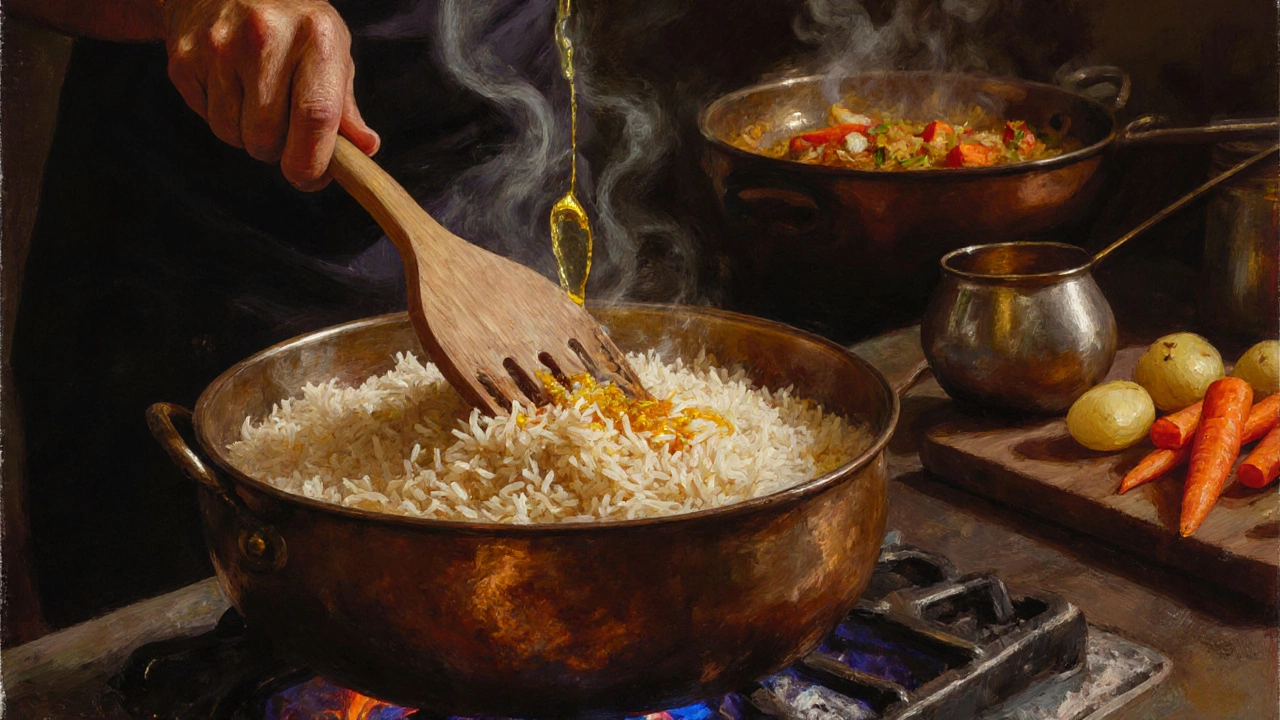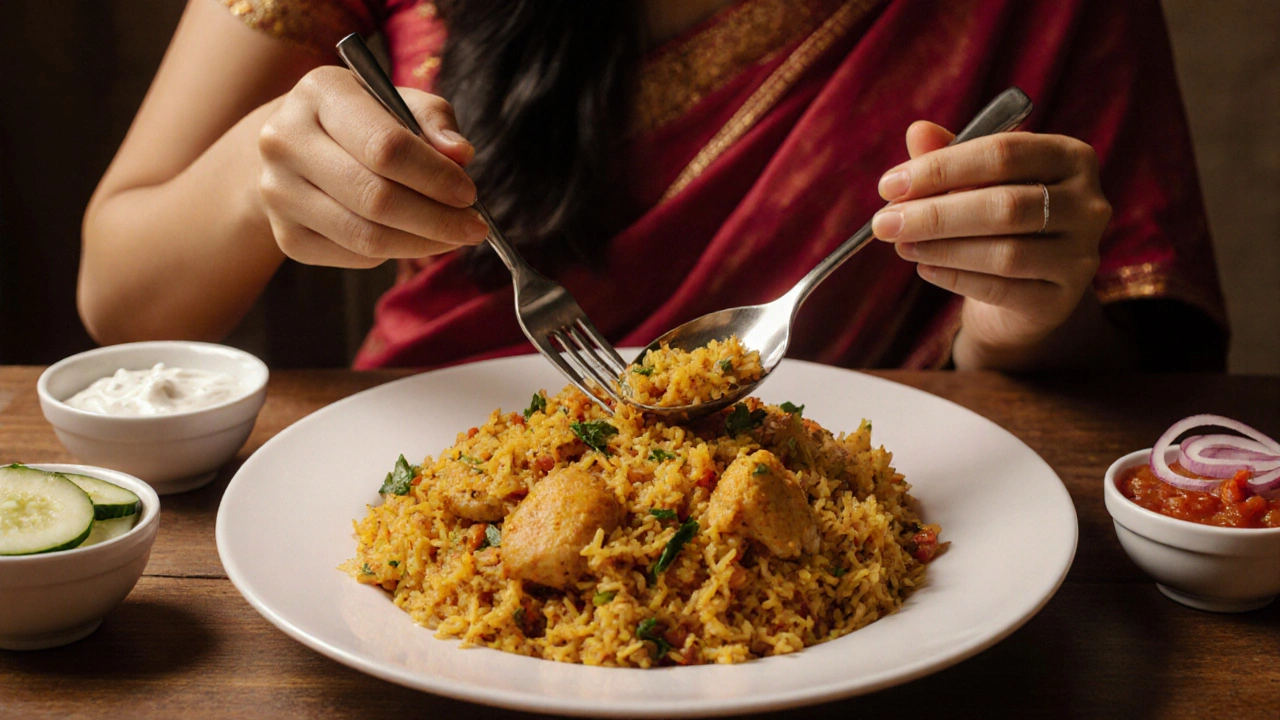Biryani Utensil Selector
Choose the type of biryani you're planning to eat to get the recommended utensil for the best dining experience.
Recommended Utensil:
Ever wondered if there’s a right way to eat biryani without offending anyone at the table? You’re not alone. From the first aromatic spoonful to the final bite of fragrant rice, the experience is as much about tradition as it is about taste. Below is a no‑fluff guide that walks you through everything you need to know-whether you’re using a fork, a spoon, or even your hands.
TL;DR
- Mix the rice and gravy gently before you dig in.
- Serve biryani with cool raita, fresh salad, and a crisp papad.
- Use a spoon for layered biryani; a fork works for softer varieties.
- Never scoop the top crust (the “tarka”) before the bottom layers.
- Enjoy the meal slowly-savor the spices, not just the calories.
What Exactly Is Biryani?
Biryani is a spiced rice dish that traditionally incorporates marinated meat, vegetables, and a blend of aromatic herbs like saffron, cardamom, and cloves. Originating in the Indian subcontinent, it has regional twists-from Hyderabad’s fiery chicken biryani to Kolkata’s subtly sweet egg version. The hallmark of good biryani is the “dum” cooking method: sealing the pot and letting the flavors meld over low heat.
Traditional Accompaniments
Serving biryani alone feels incomplete. Here are the most common side dishes, each introducing a balancing texture or cooling effect.
- Raita is a yogurt‑based sauce flavored with cucumber, mint, and a pinch of cumin. It tames the heat and adds creamy contrast.
- Salad (typically sliced onions, carrots, and lemon wedges) adds crunch and a bright citrus note.
- Papad (or papadum) is a thin, crisp lentil wafer that’s either fried or roasted, offering a satisfying snap.
- Pickles (achar) bring tangy, salty bursts that complement the rice’s richness.
- Ghee drizzled sparingly adds a fragrant buttery finish.
These sides aren’t just garnish; they’re part of the biryani experience, each playing a role in balancing flavors and textures.

Hands, Spoon, or Fork? Choosing the Right Utensil
The debate over utensils can be surprisingly passionate. Your choice should depend on the biryani’s consistency and the setting.
| Biryani Type | Best Utensil | Why? |
|---|---|---|
| Layered Hyderabadi | Spoon | Allows gentle mixing of rice and gravy without breaking layers. |
| Soft Chicken (Kolkata) | Fork | Rice grains are tender; fork separates meat and rice easily. |
| Street‑style (hand‑pulled) | Hands | Authentic experience; rice sticks together for easy scooping. |
| Vegetarian (Paneer or Mixed Veg) | Spoon or Fork | Both work; spoon helps blend the gravy, fork offers control. |
In formal settings, a spoon is the safest bet. At a family gathering, you might see elders using their hands-this is perfectly acceptable and often encouraged for a more tactile connection with the food.
Step‑by‑Step: How to Eat Biryani Properly
- Inspect the platter. Look for the golden “tarka” (fried onions, ghee, and nuts) on top-this is the flavor crown.
- Mix gently. Using the back of your spoon or fork, lift a small section from the middle, turning the rice over the gravy. This ensures every bite gets the full spice profile.
- Add a side. Spoon a dollop of raita onto the side of your plate. A small bite of raita with each forkful keeps the heat in check.
- Take a bite. Aim for a combination of rice, meat (or veg), and a pinch of the tarka. The goal is a balanced flavor-spicy, aromatic, and slightly sweet.
- Repeat the rhythm. Alternate between biryani and side dishes. The contrast between hot, spiced rice and cool yogurt is what makes the meal sing.
Remember, biryani is meant to be enjoyed slowly. Rushed eating dulls the palate and defeats the purpose of the carefully layered spices.
Common Mistakes to Avoid
- Skipping the tarka. The caramelized onions and nuts add depth; ignoring them leaves the dish flat.
- Over‑mixing. Vigorous stirring crushes the rice grains and turns the biryani mushy.
- Using the wrong side dish. Heavy, creamy sauces mask the biryani’s nuances. Stick to light raita or fresh salad.
- Eating it cold. Biryani shines when served hot; reheating should be done on low flame with a splash of water to revive steam.
Pro Tips from the Kitchen
- Finish with a squeeze of lemon. A few drops brighten the flavors right before the last bite.
- Serve on a banana leaf. In many South Indian homes, the leaf adds an earthy aroma and keeps the rice from sticking.
- Pair with a simple dahi‑mirchi. This green chili‑yogurt condiment offers a gentle heat that complements rather than competes.
- Keep a small bowl of water nearby. A sip between bites cleanses the palate and readies you for the next spice level.

Frequently Asked Questions
Can I eat biryani with a fork if I’m at a formal dinner?
Yes. A fork works well for softer biryanis where the rice isn’t tightly packed. Just use the back of the fork to gently lift layers without crushing the grains.
Is it okay to skip raita and just eat biryani alone?
You can, but you’ll miss the cooling contrast that raita provides. The yogurt’s mild tang balances the heat of the spices and keeps the palate fresh.
What’s the best way to reheat leftover biryani?
Warm it on low heat in a pan, add a tablespoon of water, and cover for a few minutes. This restores steam and prevents the rice from drying out.
Do I need to use my hands for authentic biryani?
Hand‑eating is traditional in many regions, especially for street‑style biryani, but it’s not mandatory. Choose whatever feels comfortable for you.
How much raita should I serve with biryani?
A small ramekin (about ½ cup) per person is enough to add a cooling bite without overwhelming the rice.
